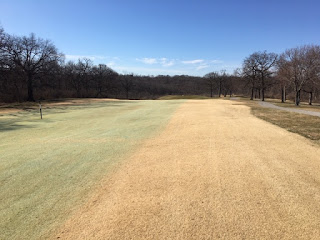March brings golf, and a vacation.
(Salt Lake City Skiing Views)
What a winter we've had! Snow, bitter cold, and a Superbowl win has blessed us here in KC. Winter season is always great for golf course superintendents. There is no grass growing, no golfers growling, and time for us to actually take a step back and relax for a short time. We are able to catch up on all the small jobs that are difficult to get done during our busy spring/summer/fall season. As for myself, there was also time to slip away and take a needed vacation. Skiing in Salt Lake City was an awesome experience, but with temperatures in the high 50's back home, I returned back to the machine called Swope Park already up and running.
We've had two major winter projects. First, we trimmed, limbed, dropped and chopped up the low hanging and encroaching trees along the parking lot wall. Historically, we believe it was possible to see from the club house directly down to the KC Zoo. Years of tree and undergrowth later, it was a wall of honeysuckle and 20 year old trees. Cleaning these trees up will not only improve the aesthetics of the parking lot, but also reduce the chance of a limb or tree falling on a patrons car and/or blocking the path at 5 o'clock on a Friday.
(Part of the wall cleanup.)
Project number two has roots that grow back to, maybe the 1970's? The existing tee signage is an aluminum, square plate, with 3 yardages and the hole number. The information is correct on them, however there isn't much other info, nor any feature to catch a person's eye. Since I've been employed here, since my boss has been employed here, since my boss's boss was employed here, there is a stack of old tee signs in the basement of Swope. There are large, stone signs that have the hole yardage as well as the hole layout. Originally the signs were in wooden post frames, and they were rotted and falling over. The superintendent at the time took them down, stored them in the basement with the intention of fabricating new metal housing for each sign and use hanging bracket system. The plan never grew to fruition and the stones started collecting dust. Enter Matt Nash, our new mechanic. Matt has an immense background in metal fabrication. Coming from BTM Manufacturing with over 15 years experience, Matt formed, welded, and painted a bracket and sheath for each and every sign, while myself and Sam power-washed and repainted each sign. After installing a few new poles for holes with multiple signs, the course has Tillinghast era tee signage again. Still to come, names for each hole.

(Cleaning up the stones.)
(Digging a new post hole on #15.)
(#1's final product, missing the hole name plate: Hope)
As I said before, the machine was up and running when I returned from my Mormon vacation. Greens were mowed, new cups were cut, and zoysia was sprayed all before March 3rd. The zoysia is sprayed to reduce anything other than zoysia to grow in our fairways: poa, clover, goose/crabgrass, etc. The zoysia is currently dormant, so any product applied to the plant will not be absorbed or used by the zoysia. However, any thing else growing in the fairway will die out and allow the zoysia to fill in once warm weather appears.
(#12 during spraying.)
(Sam perfectly spraying #12. A very photogenic Superintendent.)
Once we finish spraying our tee tops, we will return our newly painted tee markers and our enter/exit signs in the fairways. The season is upon us, and we are ready.
Fix your divots!





























